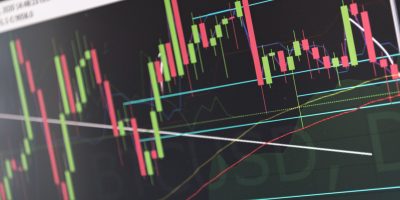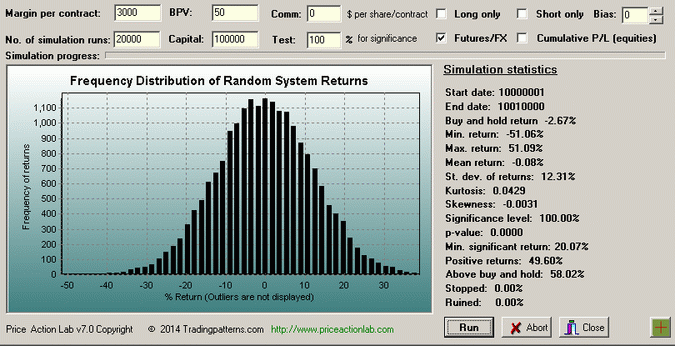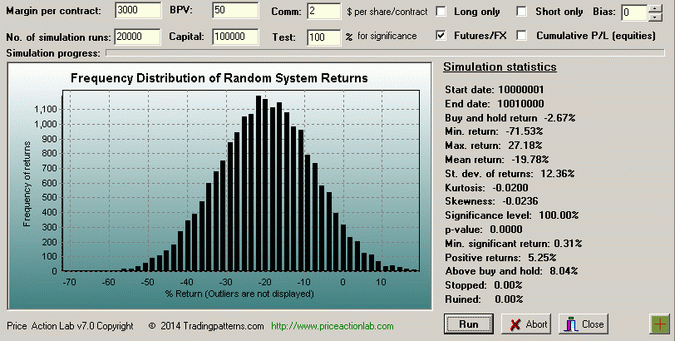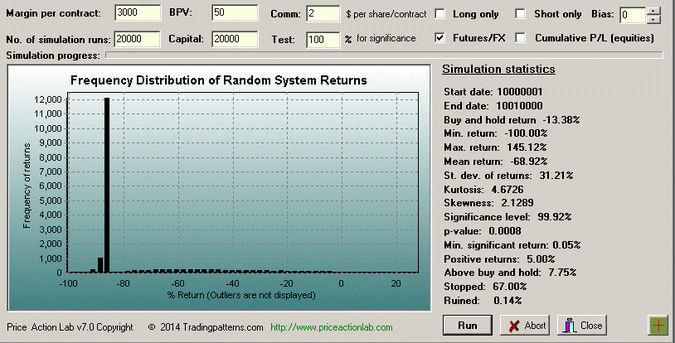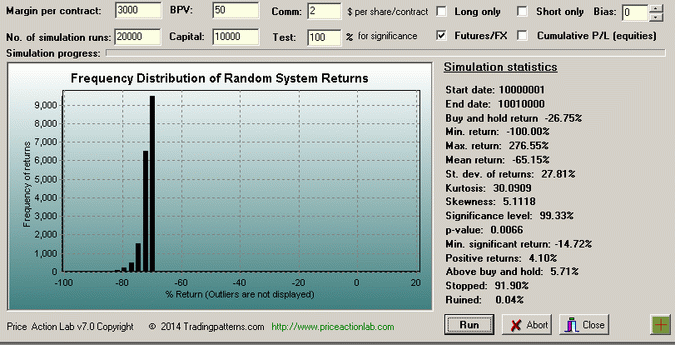This is part one of a four part series on the perils of day and position trading in futures and forex markets. In Part One, analysis based on a simulation of a large number of random systems confirms the empirical fact that only a tiny percentage of day traders in E-mini S&P 500 futures market are profitable.
Day trading is a popular style based on intraday timeframes, such as 1-minute, 5-minute, 30-minute or even faster time intervals. All trades executed during a day are exited before market close.
Although it is well-known that profitable futures day trading offers low chances of success, many traders hope of beating the odds because they believe they have an edge. In most cases, the assumed edge is either a lucky streak of winners or some curve-fitted algo on past data. Although there may be edges in intraday timeframes, over time most cannot cover transaction cost and losses accumulate.
A random sample of 10,000 bars of the E-mini S&P 500 futures (bars numbered 10000001 to 1010000) was selected from historical 15-minute data. This sample was used to perform the following simulation:
1) A fair coin is tossed before the close of the first bar of the data sample. If heads shows up, then any open short position is closed and one futures contract is bought at the close. Any open long position is closed and one contract is sold short when tails show up. This is repeated until the end of the sample and then the net return of the resulting sequence of entry and exit points (system) is calculated. A random system is stopped if its initial equity is reduced below the required margin. Ruin occurs when equity drops close to zero.
2) The simulation in (1) is repeated 20,000 times.
3) A distribution of the 20,000 net return values is plotted and several statistics are calculated.
An initial margin of $3,000 was used in all simulations.
Case 1: Frictionless day trading: Initial capital: $100,000, Commission each way: 0
Below is the distribution of the returns of the 20,000 random entry and exit sequences generated by tossing the fair coin:
The above distribution confirms the zero-sum nature of futures trading: 49.60% of random systems, i.e., nearly 50% of them, were profitable with a mean return of -0.08%. The distribution is close to normal with a small kurtosis and skewness. No systems were stopped or ruined. The lowest return was -51.06% and the highest was +51.09%. Since the buy and hold return was -2.67% in the simulation period, about 58% of the random systems exceeded that.
Case 2: Initial capital: $100,000, Commission each way: $2
Next, we apply $2 commission each way to all trades and repeat the simulation for the same initial capital of $100,000. Below is the new distribution of the net return:
The introduction of the small commission charge had a catastrophic effect on the distribution of returns. Only 5.25% of the random systems make a profit but due to the large initial capital there are no stopped or ruined systems. The mean return is now -19.78%. The results due to a lower initial trading capital may now be evident, even before the simulation is repeated.
Case 3: Initial capital: $20,000, Commission each way: $2
Next, we lower the initial capital to $20,000. Commission remains at $2 each way. Below is the new distribution of the net return of the 20,000 random systems:
Due to the spike at the left, denoting the number of stopped systems, the distribution is barely visible but it has mean return of -68.92%. With $20,000 initial capital, 67% of the random systems are stopped and 0.14% of them are ruined. Only 5% of the random systems are profitable, about the same fraction as in the case with the $100,000 initial capital. These results confirm estimates that about 95% of day traders lose.
Case 4: Initial capital: $10,000, Commission each way: $2
Next, we lower the initial capital to $10,000. Commission remains at $2 each way. Below is the new distribution of the net return of the 20,000 random systems:
As expected, after lowering the initial capital to $10,000, about 92% of the random systems are stopped. About 4% of the systems generate a profit. Again, this result confirms estimates that only a tiny percentage of day traders, about 5%, profit.
Objections
It is expected that the following objections may be raised regarding the interpretation of results of this study.
1. The simulation was based on random system but my system is not random
Answer: In logic, if one claims that unicorns exist, the burden of proof is on him and not on those who object. Similarly, if someone claims to have an edge in trading, the burden of proof is on him to prove it. However, that may not be possible, as in the case of unicorns. Notice how in the last simulation the highest return was 276.55% due to the large leverage resulting from the lower capital. Because of leverage, high returns cannot be used for proving an edge, unless they are properly adjusted for that. In other words, profitability is not an edge because it may be the result of luck. An “edge” is something else but to claim one, one must first prove that edges exist in general. This is a complicated problem and, possibly, it has no solution.
2. A coin toss is not a trading system. I trade with the XYZ indicator
Answer: Whether you toss a coin or you use an indicator, performance is calculated based on entry and exit signals. When looking at sequences of entry and exit signals, they all look similar regardless of the method used to generate them. More importantly, one or even some of the random sequences may look quite similar to those generated by some indicators or group of indicators. Even more importantly, one must prove that the indicator used is better than a coin toss system and that may be difficult to do in most cases. We cannot exclude the possibility that there are indicators that have predictive ability on intraday data but that must be proven using proper statistical analysis. Suffice to say that most known technical analysis indicators generate random signals.
3. If futures day trading is a negative-sum game, why is it so popular?
Answer: This happens because 99% of the trading literature involves unsupported claims of day trading success and trading gurus would have no subject if they admitted the low success rate.
4. Where do some pros get their edge from?
Answer: Pros profit either from making markets or from the presence of a large number of unskilled and uninformed traders. Pros like to see more of those trading books for the masses based on unsupported claims of success that lure more potential losers to the markets.
Part two in this series will be about daily futures trading. The analysis about forex trading will follow. So stay tuned!
You can subscribe here to notifications of new posts by email.
© 2015 Michael Harris. All Rights Reserved. We grant a revocable permission to create a hyperlink to this blog subject to certain terms and conditions. Any unauthorized copy, reproduction, distribution, publication, display, modification, or transmission of any part of this blog is strictly prohibited without prior written permission.
